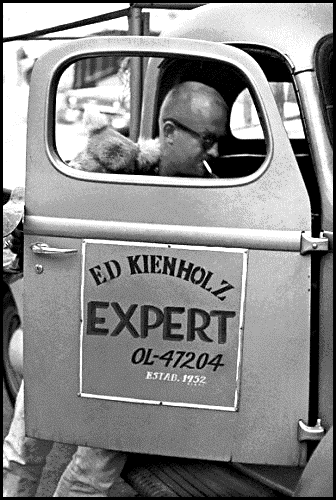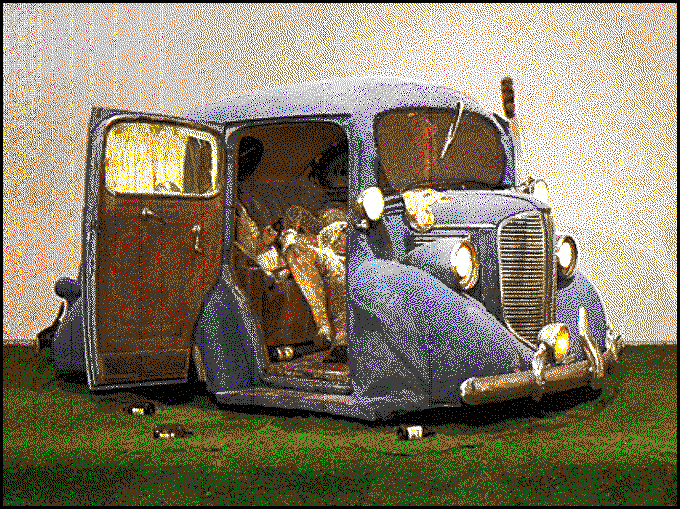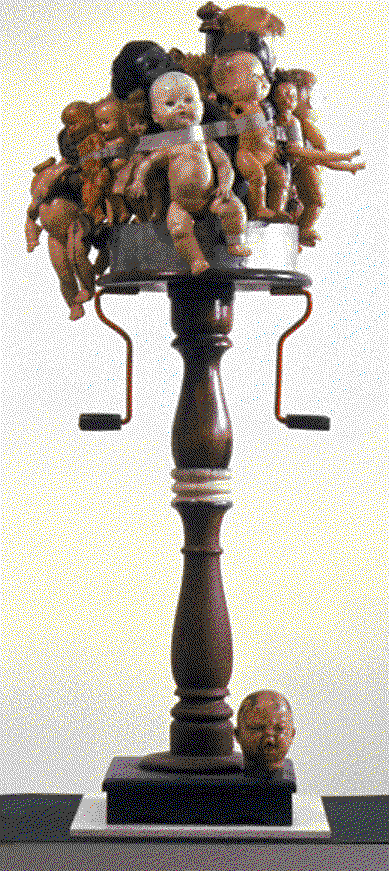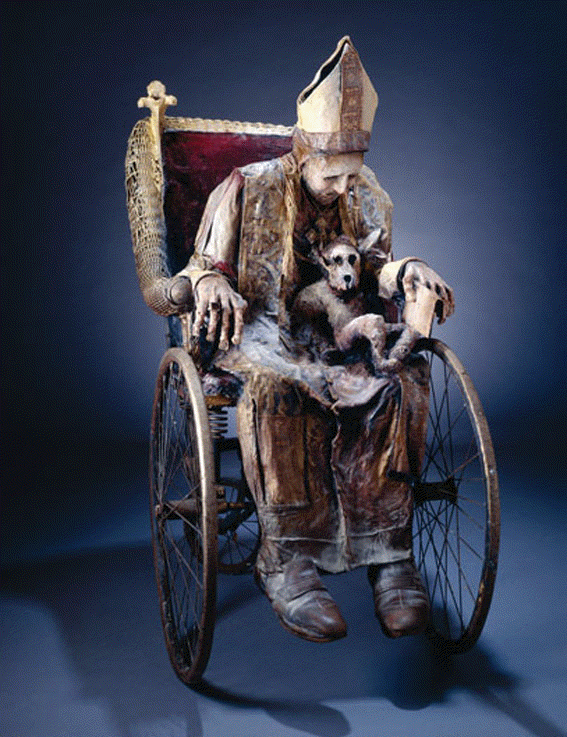Los Angeles Art:
1945 - 1980
Rebecca Peabody et al
(Getty Research Institute)

There are also thirty-nine unincorporated communities and sixty or so CDI's ("census designated places") with names like Athens, Cornell, Neenach and Pearblossom. Finally, we have five dozen "ghost towns," including Pubugna, Quapa, Sibagna, Saway-yanga and (wahoo!) Wahoo. Next door, in case we need any more CDPs, there are the thirty-three cities of Orange County, and the ten cities and twenty-four unincorporated communities of Ventura County.
Thus when anyone, much less the Getty Institute, announces a book of "Los Angeles Art," we might ask which Los Angeles we are referring to. Is it the art of Chowigna, or Cucamonga, or Santa Monica, or Long Beach? And artists are always moving around, fleeing the police or landlords, or, according to this book, outraged city council members, or museum board members, or the House Unamerican Affairs Committee. When they are on the lam, where are they being artists from? Kinneloa Mesa or Hi Vista? Or Pearblossom?
As all worthwhile artists should or must do, those of the 50s pissed off the city fathers. And the "supporters of the arts." Plus your average taxpayer who, reading the L. A Times (1950s version), must have assumed the worst.
Such as when they find that the L. A. County Museum of Art has put Edward Keinholz's "Back Seat Dodge '38" on view: a mise-en-scène that shows a rather truncated coupe complete with rather truncated couple (open door, legs and torsos scattered hither and yon, conjoined in the dusky interior with beer bottles on the ground and undies on the hood). It was what one city council supervisor termed "pornographic," "revolting."
Then there's the show that had been labeled by the California Art Club as demonstrating a "communist taint," utilizing "radical" artists with "a good education but without a good sense of taste." As proof, a painting from 1949, by Rex Brandt, titled "First Life of the Sea," shows a couple of sailboats and a light buoy, in the style of early Cezanne. It was seen as "subversive" by City Council member Harold Harby. He called it "stinkweed stuff," claiming that it was an ill-disguised depiction of "a hammer and sickle."

Pacific Standard Time --- the title makes it sound like the original clockwork orange --- is an enormous if not loving work trying to encapsulate the L. A. art scene from the end of WWII to 1980. But as "Los Angeles" consists of hundreds of disparate communities sprawled all over the L. A. basin, this elegant volume shows a sprawl of art that could never be contained in one venue. No matter how large the book (over three hundred pages), no matter how weighty (eleven pounds), no matter how diverse, the "art" of L. A. is not to be captured so easily. And the Getty is trying: there are here over five hundred reproductions, drawings, photographs, fixed in five chapters with thirty-one "sidebars," including painting, sculpture, architecture, dance, theatre, radio, video, and murals.

And one has to take into account the conflict that art must foist off on a "community" of 10,000,000 souls. L. A. patchwork towns tended to be small and drab, a reflection of the small and drab people who moved here from Iowa and Nebraska and Missouri and Texas and Utah ... citizens with little more than officious little thoughts about what constituted "Art." I doubt that Standard Time represents them and their flowers-in-the-garden moon-on-the-ocean, weekend Art Fair paintings and drawings and fretwork that turn up at the local park shows.
For example, take the Watts Towers on E. 107th Street, constructed by Sabato Rodia between 1921 and 1954. Evidently the Getty people consider this the first art of that period, for it turns up very early on in the book. But not only were the people of Watts indifferent to the towers, they were actively hostile (these weird bastards are going to collapse on my house and kill my children.) Towards the end there, Rodia was in conflict with the Los Angeles City Building department and the city Planning Department (problems not discussed here) which may have driven him away.
He didn't have a permit, and what he was doing was certainly not up to code. Imagine going to City Hall and asking for a permit to build three Gaudí-style towers out of old broken bottles and bottle caps, hub caps, auto parts and various found objects.
It was assumed by all that he was bonkers. It was also assumed that the city would tear down the towers as a public nuisance sooner rather than later --- it almost happened. Art does not find an easy home down here in Lotus land.
Outside of the Watts Towers, and not finding much indigenous art in southern California, the earliest chapters here treat with the collectors (the Arensbergs, Galka Scheyer, Vincent Price, Charles Laughton, Fanny Brice) or the artists who visited from other venues: Man Ray, Duchamp, Dalí.
In general, most of the art that does appear throughout the book is pretty dreadful stuff: vile stoneware by Peter Voulkos and Henry Takemoto, vulgar ceramics by Ken Price, lurid constructions by Ed Bereal, sloppy assemblages (on burnt wood with other debris) by Noah Purifoy. Some of these are so fearsomely ugly as to be a clear and present danger to the gentry and should have been declared a public nuisance like the Towers.
Still, there might have been some pride in the we-were-there-first with Irving Blum's 1962 show of Warhol's Campbell Soup Cans. Except for the many of us at the time (I wasn't the only one, I promise) who thought that industrial art might best have been left in the kitchen where it belongs. Or even better ... in the garbage can where it would fit right in and could be dumped the following day.
That big pale washed-out bore David Hockney takes up too many pages halfway through this book, followed by some plastic nonsense by Craig Hoffman, Billy Al Bengston, and Ken Price (again) --- and some terribly camp pre-Stonewall stuff from Bob Mizer, Tom of Finland and Hockney (again). Finally, there are various fogs, nets and "installations" that appear towards the end. All manage to be, at least for this critic, pretty silly stuff.
For all its careful lengthy essays by Ms. Peabody et al, we suspect is that if the Getty had stopped with the great Ed Kienholz and his zany friend Walter Hopps, we --- and possibly the book --- would have been better off. "Back Seat Dodge" --- which is not shown here except as a fuzzy picture reproduction from the Times, --- was a show-stopper to those of us of the 50s. It was a most apt symbol of our love life.
For we knew we had somehow to get out of the house, disappear into one of those turn-offs near Mount Wilson or over in the carparks in Ventura --- anywhere to get our parents off our backs and our rocks off with our young delicious tanned salty loves. The cars we were forced to jook around in (this was the 50s) were tiny and crowded with uncomfortable seats and all manner of protruding knobs and gears and shifts. Trying to cop a feel in the back seat with your knees in your face and a seat coil spring up your ass certainly made us believe that these foreshortened cars by Kienholz fit our reality to a T.
It is right and proper that representative George A. Dondero, on the floor the U. S. House of Representatives, could rail at what he called
- the roll of infamy without claim that my list is all inclusive: Dadism, futurism, constructionism, suprematism, cubism, expressionism, surrealism, and abstractionism. All these isms are of foreign origin and truly should have no place in American art. While not all are media of social or political protest, all are instruments and weapons of destruction ... Cubism aims to destroy by designed disorder ... Expressionism aims to destroy by aping the primitive and insane. Abstractionism aims to destroy by the creation of brainstorms. Surrealism aims to destroy by the denial of reason.
